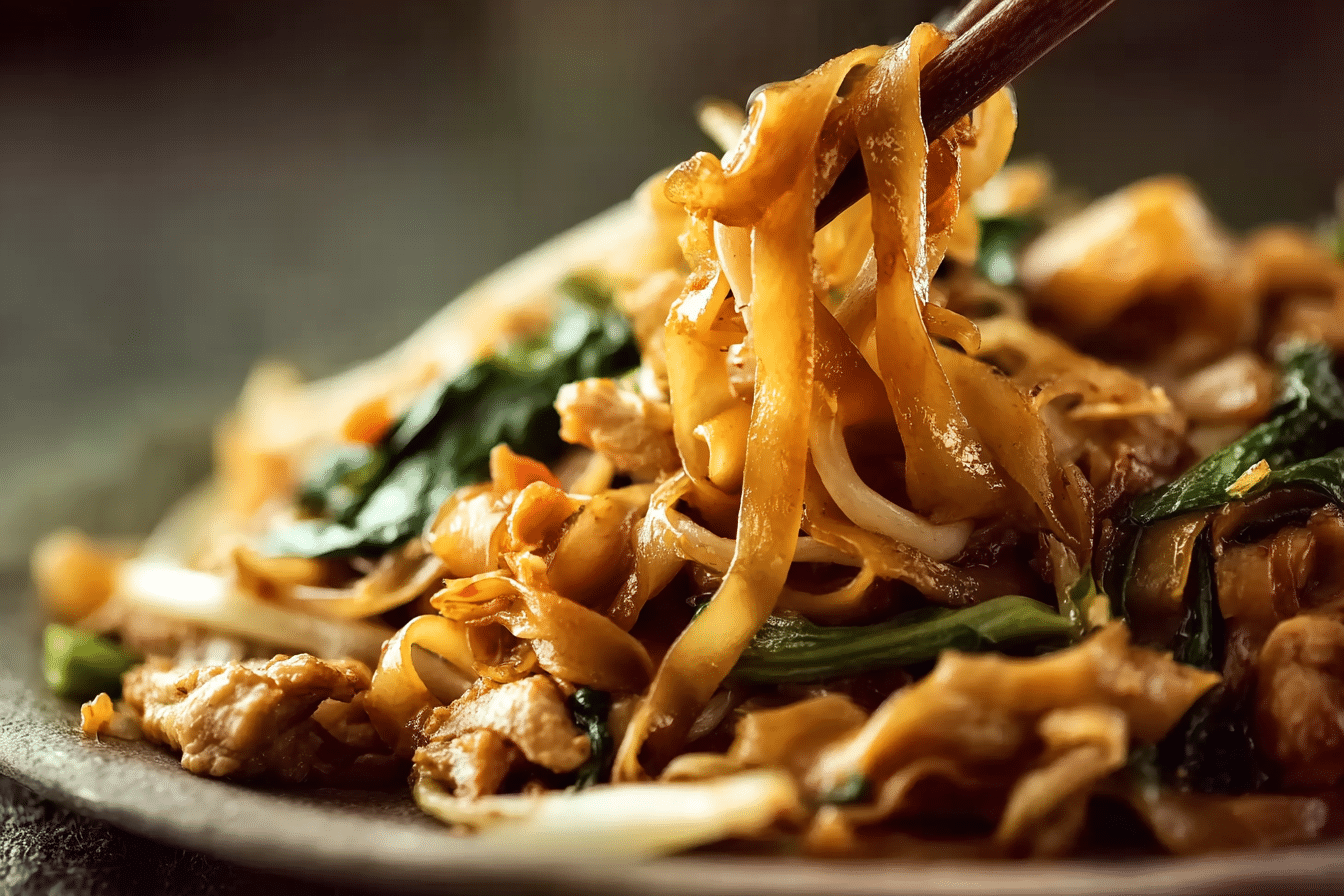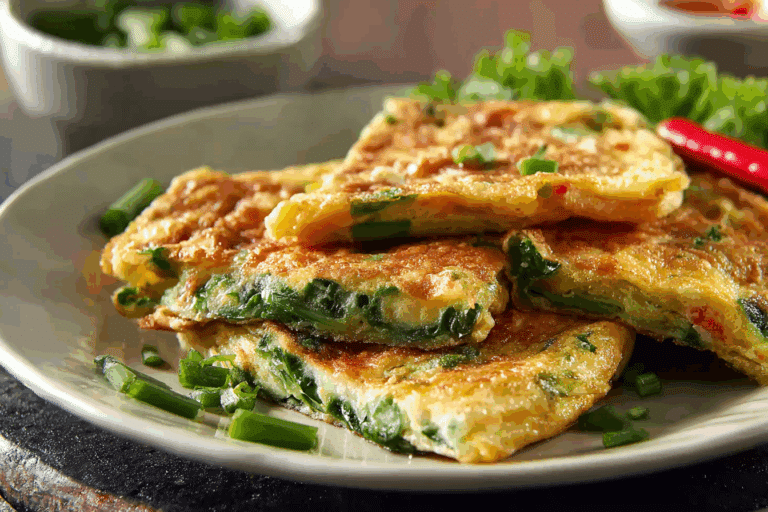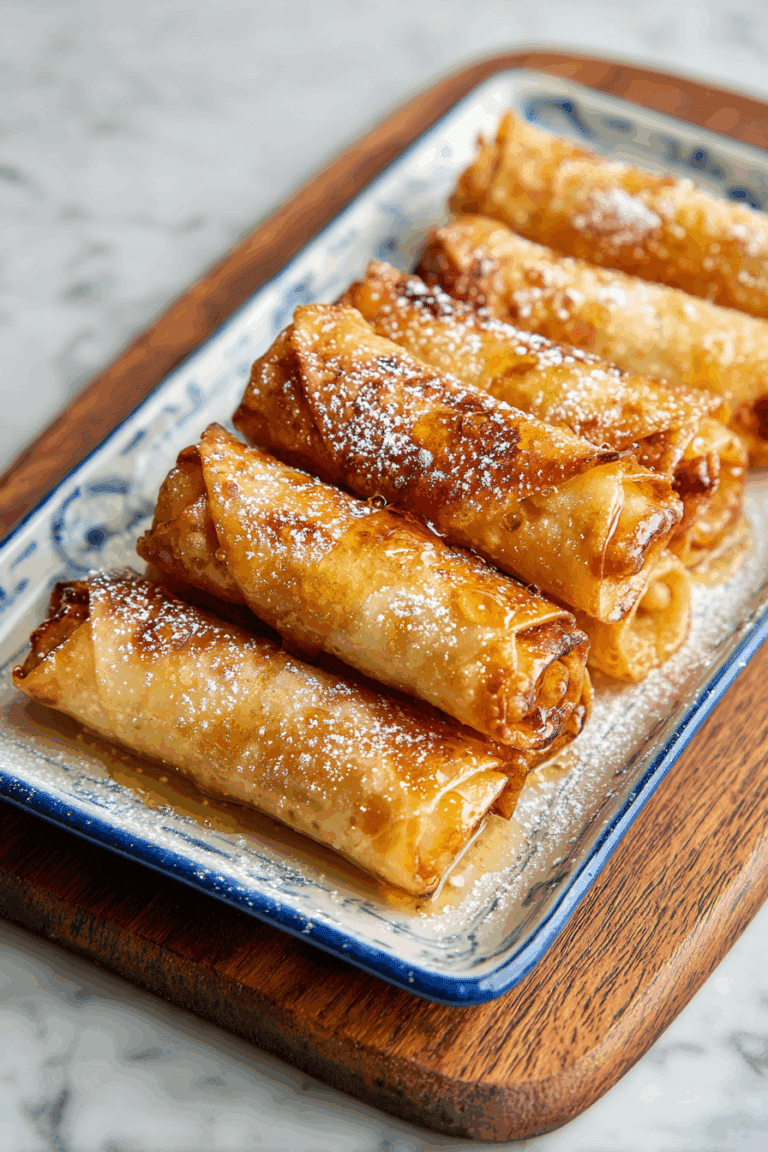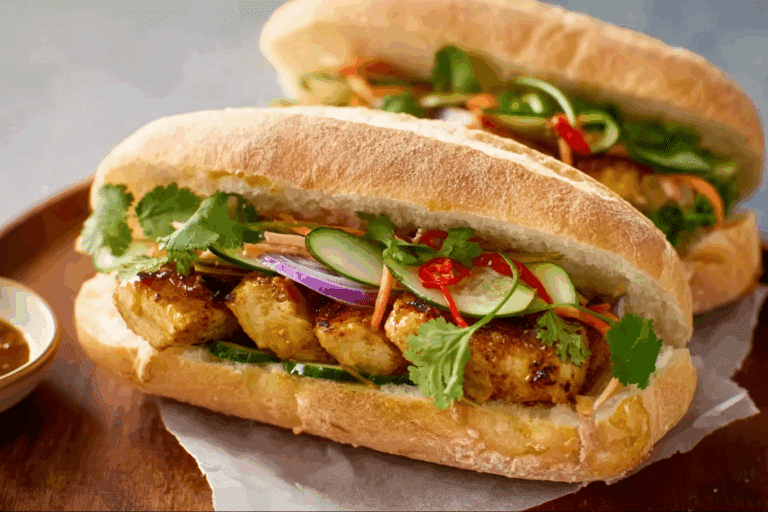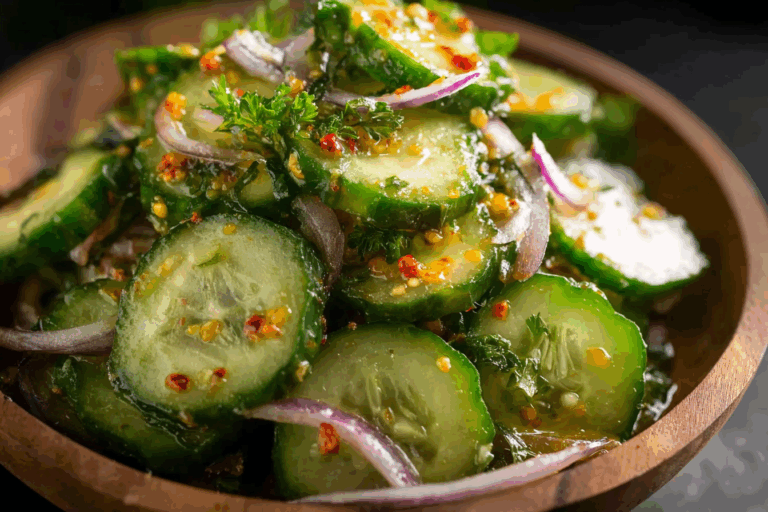Thai Stir Fried Noodles: Discover the Magic of Authentic Flavor
Thai Stir Fried Noodles are one of those dishes that bring people together at the table. When I first began sharing my love for Thai cooking on my About page, I mentioned how food was always the bridge between cultures in my family. I grew up in a kitchen where different aromas filled the air, and the joy of discovering new flavors was part of everyday life. That story is still the heart of why I love cooking today, and Thai Stir Fried Noodles are a perfect example of that passion.
This dish is often called Pad See Ew when made with wide rice noodles and a sweet savory sauce. It is one of the most comforting Thai meals you can make at home, and yet it always feels like a restaurant-quality dinner. The noodles caramelize in the pan, the chicken cooks with garlic until fragrant, and the Chinese broccoli gives it a fresh crunch that balances everything. It is easy to see why Thai Stir Fried Noodles are a favorite for weeknight dinners and special occasions alike.
In this post, you will learn exactly how to make authentic Thai Stir Fried Noodles in your own kitchen. I will walk you through the ingredients, step-by-step cooking process, storage tips, common mistakes to avoid, and even a little cultural background on how this noodle dish became so loved around the world. If you love recipes like Pad Thai or stir fry noodles with vegetables, you are in for a treat.
Before we dive into the ingredients, I want to share something important. Cooking at home should feel enjoyable, not stressful. The recipe I am sharing today is flexible, meaning you can use chicken, tofu, shrimp, or even go vegetarian. You can find most of the ingredients at a regular grocery store, but if you stop by an Asian market you will discover even more authentic touches to make your Thai Stir Fried Noodles taste just like they came from a Thai street vendor.
So let’s start this journey and make your kitchen smell like a little Thai restaurant.
Table of Contents
Table of Contents
Ingredients for Thai Stir Fried Noodles
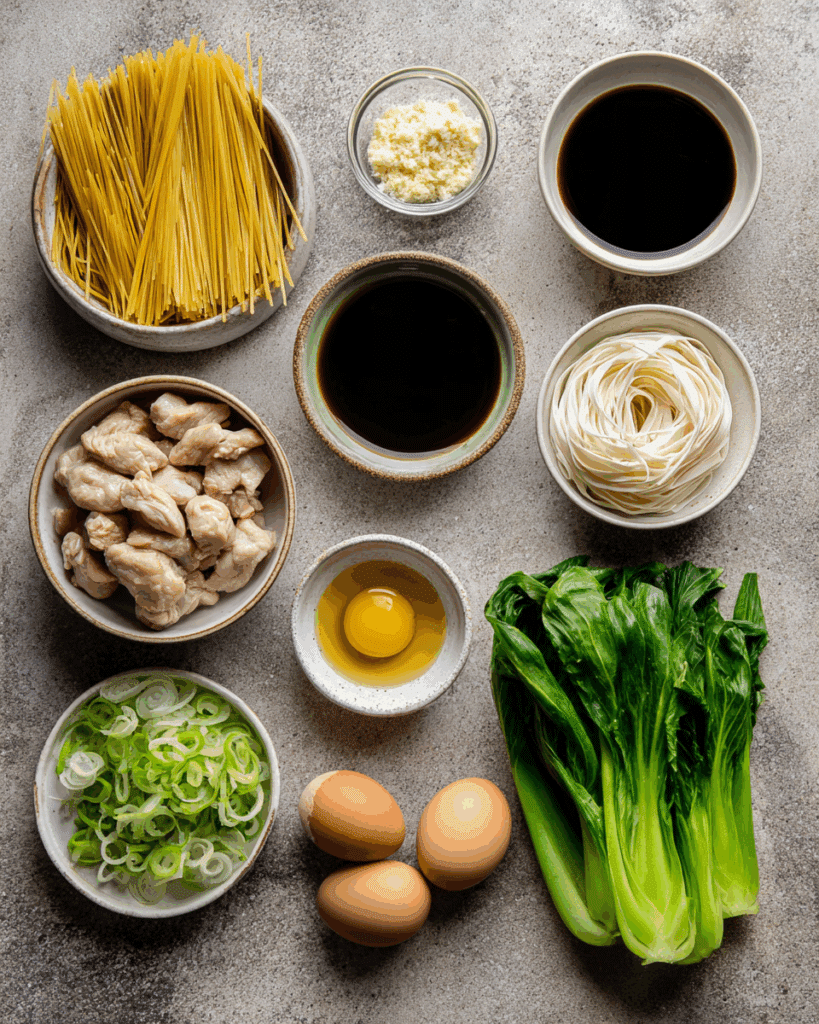
To make authentic Thai Stir Fried Noodles, you will need a few pantry staples and some fresh vegetables. The good news is that once you gather these ingredients, you can recreate this dish again and again with endless variations.
Noodles
- 200g / 7 oz dried wide rice stick noodles, or 15 oz / 450g fresh wide flat rice noodles (Sen Yai)
Sauce
- 2 tsp dark soy sauce
- 1 1/2 tbsp oyster sauce
- 1 tbsp light soy sauce (or all-purpose soy sauce)
- 2 tsp white vinegar
- 2 tsp sugar (white sugar works best, but brown sugar is fine too)
Stir Fry
- 3 tbsp peanut or vegetable oil, divided
- 2 garlic cloves, finely chopped
- 1 cup / 150g chicken thighs, boneless and skinless, sliced
- 1 large egg
- 4 stems Chinese broccoli, cut into 3-inch pieces, stems separated from leaves
A few notes about the ingredients. The noodles are key. Wide rice noodles give the authentic chewy texture that Thai Stir Fried Noodles are known for. If you can find fresh Sen Yai noodles at an Asian grocery store, grab them. If not, dried wide rice stick noodles will work beautifully.
The sauce is a mix of salty, sweet, and tangy flavors. Dark soy sauce gives the dish a deep color and rich flavor. Oyster sauce adds a savory depth, while light soy sauce balances it with brightness. Vinegar adds a slight tang, and sugar balances everything out.
For the protein, chicken thighs are my choice because they stay juicy when stir-fried. You can also substitute with shrimp, pork, or even tofu for a vegetarian version. The Chinese broccoli is traditional, and its stems and leaves bring both crunch and tenderness. If you cannot find Chinese broccoli, regular broccoli or broccolini is a good substitute.
Step-by-Step Instructions for Cooking Thai Stir Fried Noodles
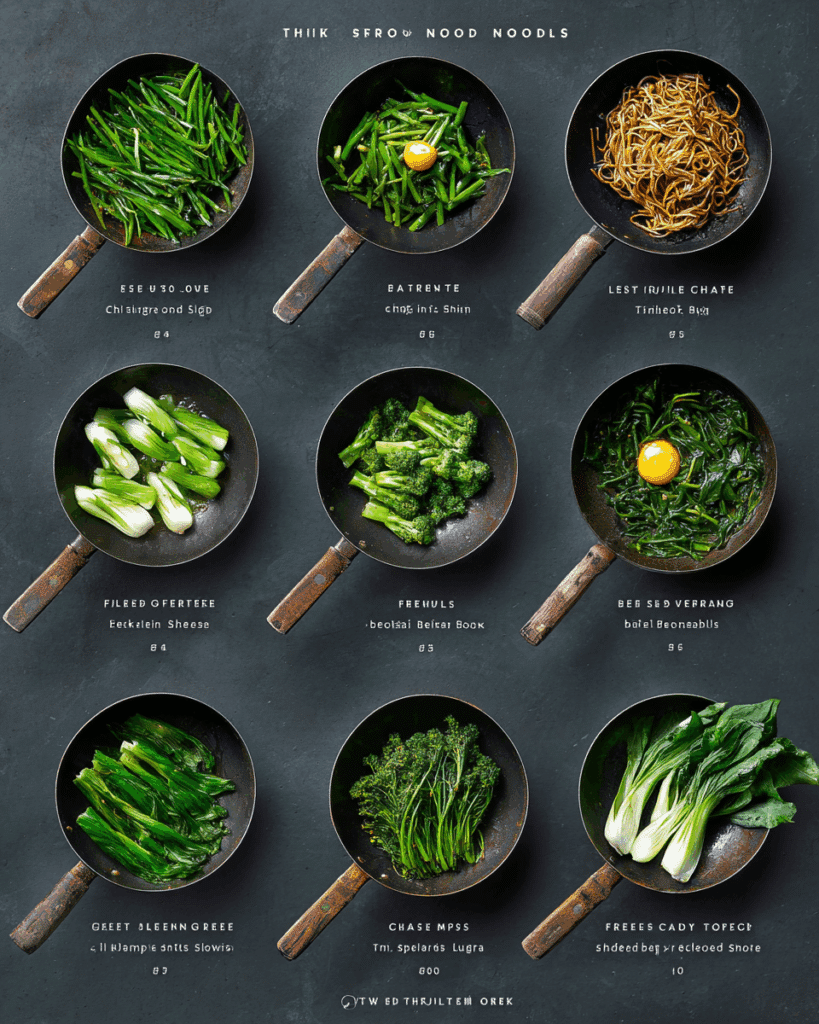
Making Thai Stir Fried Noodles is all about timing and high heat. Once you start cooking, everything comes together quickly. Here is how you can prepare it at home.
Preparation
- Prep the Chinese broccoli – Trim the ends and cut into 3-inch pieces. Separate the stems from the leaves, and slice any thick stems lengthwise so they cook evenly.
- Cook the noodles – Follow the package instructions, but be careful not to overcook. Drain well and set aside. Remember, do not let them sit too long before stir-frying or they may break apart.
- Mix the sauce – In a small bowl, whisk together dark soy sauce, oyster sauce, light soy sauce, vinegar, and sugar until the sugar dissolves.
Cooking
- Heat one tablespoon of oil in a large wok or skillet over high heat.
- Add garlic and stir quickly for about 15 seconds until fragrant.
- Add chicken slices and stir-fry until they turn white but are not fully cooked.
- Add Chinese broccoli stems and cook until the chicken is nearly done.
- Toss in the Chinese broccoli leaves and stir just until wilted.
- Push everything to one side of the pan. Crack an egg into the empty side, scramble it, and then mix it into the vegetables and chicken.
- Transfer the chicken and vegetables out of the wok onto a plate.
- Add the remaining two tablespoons of oil into the wok and heat until it starts smoking. This is the secret to caramelized noodles.
- Add the drained noodles and the prepared sauce. Toss gently, just enough to coat the noodles without breaking them. Let the noodles sit for a moment so the edges can caramelize. This should take about one minute.
- Quickly return the chicken and vegetables to the pan, toss everything together, and serve immediately.
The aroma of caramelized noodles mixed with garlic and soy sauce is incredible. Once you plate the dish, you will see the glossy noodles shining with sauce and the bright green broccoli leaves adding color.
If you want more details on techniques, a fantastic external reference is RecipeTin Eats’ Thai Stir Fried Noodles. Another excellent guide is from The Spruce Eats on Thai Stir Fried Noodles with Vegetables.
Tips and tricks for the best pan of noodles
High heat is your best friend here. When you cook at medium heat, the noodles steam and turn soft, which makes them clump. A very hot wok, or a heavy skillet that holds heat well, helps you caramelize the edges and keep everything bouncy. I like to let the empty pan heat for a full minute before the oil goes in, which gives that fast sear that makes the noodles taste like a street stall favorite.
Toss gently and not too often. Wide rice noodles are tender, and they break if you stir them like soup. Slide a spatula under a section of noodles, lift, and fold them over, then leave them alone for a few seconds so the sauce can cling and the noodles can char a little.
Balance the sauce to your taste. The base recipe is salty, sweet, and tangy. If you prefer more bite, add an extra splash of vinegar. If the noodles taste a bit flat, a tiny sprinkle of sugar wakes up the savory notes. A few drops of water can loosen a sauce that feels too heavy.
Prep everything before you start. Stir frying is a sprint, not a stroll. Have the chicken sliced, the Chinese broccoli separated into stems and leaves, the garlic chopped, and the sauce mixed. If the noodles are dried, soak or boil them right before the cooking step and drain well. If they sit too long, they stick together, and then they tear apart.
Use the right oil. Peanut oil adds a light, nutty aroma and holds up to heat. Vegetable oil works too, which is great if that is what you have. Avoid butter or olive oil, which burn too easily at high heat.
Mind the egg. Scramble the egg on one side of the pan, then fold it through the chicken and greens. This keeps the egg fluffy and keeps it from coating every noodle, which would dull the shine and change the texture.
Try a protein mix. Chicken thighs stay juicy, shrimp cooks in seconds, and thinly sliced beef is great if you like a richer flavor. If you use tofu, press it well, then pan fry it first so the cubes turn golden. When the tofu is sturdy, it holds up in the final tossing step.
Do a quick noodle test. After you add the sauce and toss once or twice, pull a noodle and taste it. You are checking chew and seasoning. If it tastes right but feels a little stiff, add a tablespoon of water and toss once more. If it tastes light, drizzle in a teaspoon more of light soy sauce.
Keep the greens crisp. Stems go in before the leaves. This simple move keeps you from overcooking the tender parts while the thicker pieces soften. If you are using broccolini or regular broccoli, cut the stems a bit thinner so they cook at the same pace.
Serve immediately. Thai noodles are at their best the moment they leave the pan. The sauce is glossy, the noodles are firm but tender, and the greens still have life. If you wait, the noodles absorb the sauce and lose their shine. Warm plates help too.
Choose your wok wisely. A carbon steel wok is ideal once it is seasoned, which makes it nonstick and smoky. A heavy cast iron skillet works well in many home kitchens because it stays hot, which is the key to those caramel edges.
Practice the minimal toss. The biggest difference between a home version and a street vendor version is confidence with heat. Add noodles, add sauce, toss two or three times, then leave them alone for a short moment. That pause does more flavor work than constant stirring.
Salt your wok, not your noodles. Season the oil with garlic and the browned bits from chicken. Those bits anchor the flavor. When you add the noodles, they pick up seasoning from the pan which makes the whole dish taste integrated.
Finish with feel. Look for shiny noodles, golden brown edges, bright greens, and chicken that is cooked through. The smell should be savory with a hint of sweet. When that is true, your pan is ready for the table.
Variations you will love
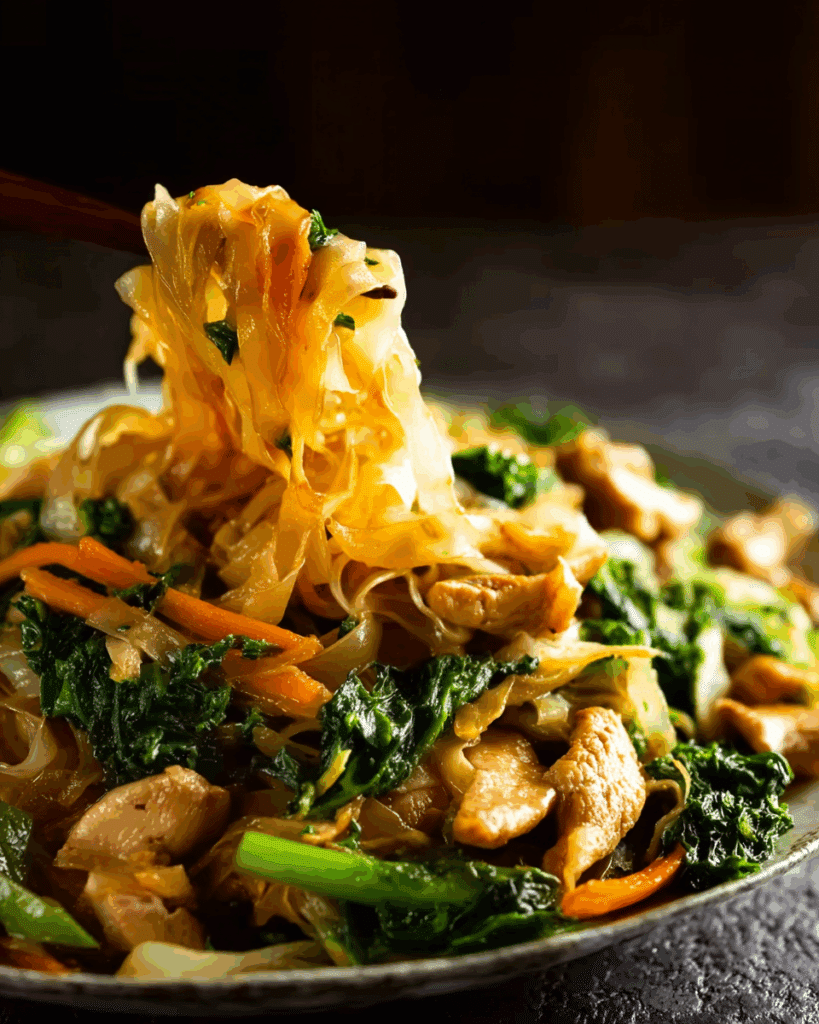
Vegetarian option. Swap the chicken for firm tofu, or use extra mushrooms for a meaty texture. Shiitake and oyster mushrooms are great because they soak up sauce and give a satisfying chew. If you want Thai stir fry noodles with vegetables only, double the Chinese broccoli and add bell peppers or snap peas for crunch.
Seafood twist. Use shrimp, scallops, or a mix. Cook them quickly after the garlic, then lift them out like you do with chicken. Add them back at the end so they do not overcook. A squeeze of lime at the table brightens all the sweet and savory notes.
Beef lover’s plate. Slice flank steak against the grain, very thin. Marinate for five minutes in a teaspoon of light soy sauce and a pinch of sugar. Stir fry hot and fast. The thin slices cook in under a minute, which keeps the noodles from overcooking.
Spicy street cart style. Add sliced Thai chilies with the garlic. If you want a deeper heat, stir in a teaspoon of chili paste when you add the sauce. Keep the rest of the recipe the same so the heat does not drown out the caramelized noodle flavor.
Extra green version. Use more Chinese broccoli, and toss in bok choy or spinach. Stir fry the stems first, then the tender leaves, then the noodles. This gives you a big bowl that feels hearty and fresh.
Kid friendly noodles. Keep the heat low on spice, add a touch more sugar to the sauce, and scramble two eggs instead of one for a softer vibe. Slice the greens smaller and cook a few seconds longer so the texture is easy for small eaters.
Gluten light approach. Use gluten free tamari in place of light soy sauce, and check that your oyster sauce label fits your needs. The noodles are rice based, which is already a plus if you are avoiding wheat.
Crispy noodle edges. If you like a little crunch, let some noodles sit untouched on the hot surface for a few extra seconds after tossing. Those spots turn golden and flaky, which adds texture to each bite.
Extra saucy plate. If you want juicier noodles, add a tablespoon of water and an extra teaspoon of light soy sauce with the sauce. Toss just enough to combine, then plate quickly so the noodles do not keep absorbing the liquid.
Breakfast favorite. Fry a sunny side egg and slide it on top of your bowl. The yolk becomes a rich sauce when you break it over the noodles. A sprinkle of black pepper at the end is lovely.
Nutrition and health benefits
Thai Stir Fried Noodles can be comforting and balanced, which is why I love serving them on busy nights. A typical serving of Thai Stir Fried Noodles with chicken and Chinese broccoli lands around a moderate calorie range for a weeknight dinner, which means you still feel light after eating. The wide rice noodles in Thai Stir Fried Noodles bring easy to digest carbohydrates for steady energy, which helps if you are hungry after work or a workout.
The chicken thighs in Thai Stir Fried Noodles provide protein that supports muscle repair, and they stay juicy, which makes Thai Stir Fried Noodles taste satisfying without needing heavy sauces. Chinese broccoli adds fiber and a good dose of vitamins A and C, so Thai Stir Fried Noodles give you greens in a way that feels craveable.
The mix of dark and light soy sauces in Thai Stir Fried Noodles brings umami, which makes a small amount go a long way. You can reduce sodium in Thai Stir Fried Noodles by using a little less sauce and adding an extra splash of vinegar for brightness.
Peanut or vegetable oil keeps Thai Stir Fried Noodles heart friendly when used in modest amounts, and the high heat cooking means Thai Stir Fried Noodles are done quickly, which helps preserve the color and snap of the greens. If you prefer a vegetarian pattern, Thai Stir Fried Noodles adapt beautifully with tofu, and the combination of tofu and rice noodles in Thai Stir Fried Noodles gives a complete feeling without heaviness.
For gluten light eaters, Thai Stir Fried Noodles are easy to tailor because rice noodles are naturally wheat free. If you are mindful of energy intake, you can portion Thai Stir Fried Noodles with more vegetables and a slightly smaller pile of noodles, which keeps Thai Stir Fried Noodles in a comfortable calorie range. The egg in Thai Stir Fried Noodles adds a bit of extra protein and choline, which is a nice nutritional bonus. If you like bold flavors, a small side of sliced chilies adds heat without changing the balance of Thai Stir Fried Noodles.
Because the sauce in Thai Stir Fried Noodles is straightforward, you can measure and track it if you follow macros. Many readers tell me Thai Stir Fried Noodles are their go to when they want a fast dinner that tastes like takeout, which keeps them from ordering something larger and heavier. When you make Thai Stir Fried Noodles at home, you control oil, sugar, and salt, which is the easiest path to a healthier plate.
Make ahead, storage, and freezing
When life gets busy, Thai Stir Fried Noodles can be prepped in smart stages. You can slice the chicken and chop the Chinese broccoli a day ahead, which makes Thai Stir Fried Noodles come together in minutes. You can whisk the sauce and store it in a jar, which gives Thai Stir Fried Noodles a consistent flavor every time.
If you plan to use dried noodles, soak or parboil them right before cooking, because precooked noodles for Thai Stir Fried Noodles turn sticky if they sit around. Fresh Sen Yai noodles for Thai Stir Fried Noodles should be separated gently with a bit of oil, then kept covered so they do not dry out.
For storage, Thai Stir Fried Noodles keep well in the refrigerator for up to three days. Store Thai Stir Fried Noodles in a shallow container so they cool quickly, which keeps the greens vibrant. Reheat Thai Stir Fried Noodles in a hot skillet with a teaspoon of water, then toss once or twice to loosen the sauce. A microwave works in a pinch, but Thai Stir Fried Noodles taste best when they hit a hot pan for a minute, because the heat revives the caramel edges.
Freezing is possible, though the texture of Thai Stir Fried Noodles changes a little. If you must freeze, cool Thai Stir Fried Noodles completely, portion Thai Stir Fried Noodles into freezer bags, and press out the air. Thai Stir Fried Noodles will keep for two months. Thaw Thai Stir Fried Noodles overnight in the refrigerator, then reheat Thai Stir Fried Noodles in a hot pan with a splash of water. Add a handful of fresh greens if you want to refresh the bowl, which makes Thai Stir Fried Noodles feel just made.
If you meal prep, store the sauce separately, then stir fry only what you will eat. This approach keeps Thai Stir Fried Noodles bouncy and bright all week, which is the entire point of cooking at home.
Common Mistakes to Avoid
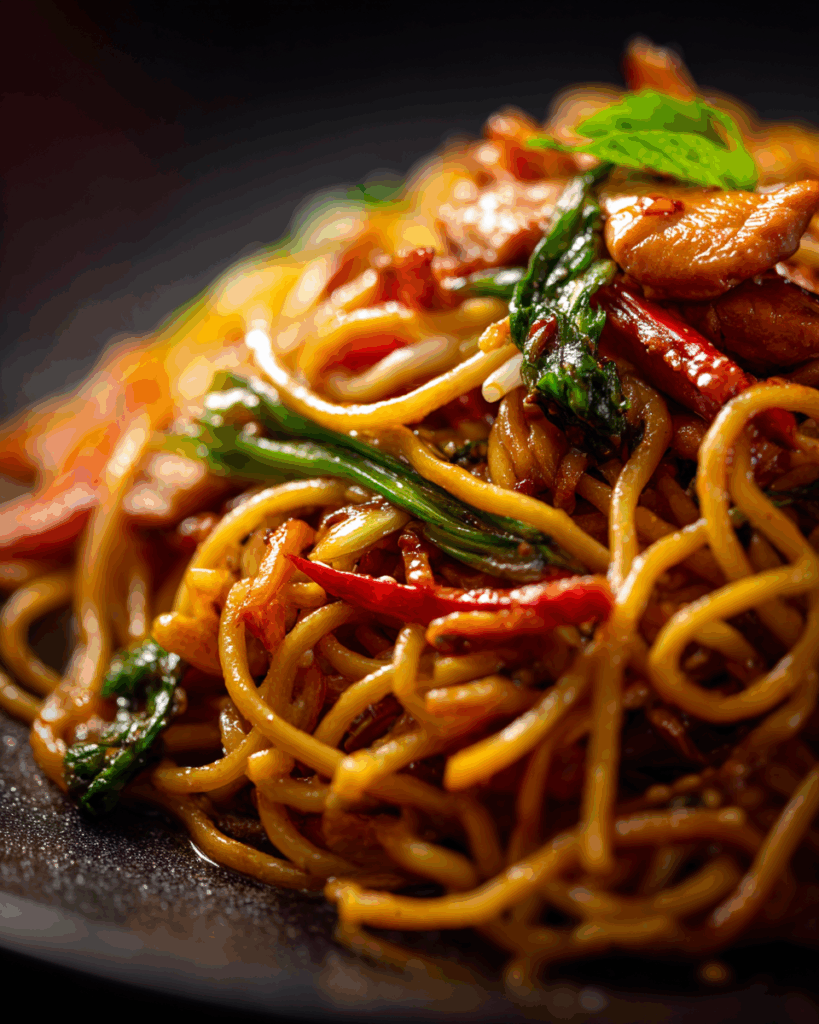
Even seasoned home cooks run into small hiccups with noodle stir fries. Here are the missteps I see most often, and how to fix them.
Noodles breaking into short pieces. This usually means they were overcooked in the pot or stirred too aggressively in the pan. Pull dried noodles from the water earlier than you think, and let them finish cooking in the sauce. In the pan, use larger folding motions instead of quick choppy stirs. A bit of patience creates those long ribbons that twirl beautifully on the fork or chopsticks.
Pale color with dull flavor. The pan likely was not hot enough when the noodles and sauce went in. Preheat until the oil just begins to smoke. That initial heat is what caramelizes the edges and deepens the taste. If your stove struggles to get very hot, cook in smaller batches so the temperature does not drop.
Greens that taste mushy. The stems and leaves cook at different speeds. Give stems a head start of about a minute, then add the leaves only until they wilt. If using regular broccoli, blanch the florets briefly in boiling water, then shock in cold water and drain. Your stir fry will regain snap and a vibrant color.
Protein that is dry or chewy. Thin slicing and fast cooking are your best friends. If using beef, slice against the grain and use a light cornstarch coating. If using chicken breast, keep the heat high and the pieces small. Pull shrimp the moment they turn pink. Rest the meat for a minute on a plate while the noodles caramelize, then add it back at the end to stay juicy.
Sauce that tastes too salty. Balance is the solution. A teaspoon of sugar can round sharp edges, while a squeeze of lime at the finish brings brightness that makes the overall flavor feel lighter. You can also add a tablespoon of water to loosen the glaze. Taste before serving and adjust in the pan. The sauce should coat the noodles without overwhelming them.
Clumpy texture. This happens when there is not enough oil for the noodles to move freely, or when there is too much liquid in the pan. Measure the oil and let it heat fully. Resist the urge to add extra water unless the noodles look dry and tight. If they do, a small splash is enough. Then let the pan do its work.
Burnt garlic. It cooks in seconds. Stir it only until fragrant, then add the protein right away. If the garlic does brown too much, scoop it out and start over. Bitter garlic can overshadow the delicate balance of the dish.
Cultural and Historical Background
Noodle stir fries in Thailand carry a story of migration and adaptation. The technique of high heat cooking in a round bottom wok came with Chinese traders and immigrants generations ago. Over time the methods blended with local ingredients and preferences.
The result is a family of dishes that feel Thai in spirit, yet echo the traditions of southern Chinese kitchens. Dark soy lends color and a hint of molasses depth. Oyster sauce brings a sea kissed savoriness. Rice noodles tie everything together with that tender chew.
Street vendors in bustling city neighborhoods often cook this dish to order. You can watch flames leap around the sides of the wok as the cook works with quick, practiced motions. The heat kisses the noodles and creates that elusive smoky aroma many people call wok hei. Home stoves do not always reach the same temperatures, yet with a hot pan and a bit of patience, you can capture much of that charm in your own kitchen.
The greens commonly used, called gai lan or Chinese broccoli, reflect the culinary crossroads of the region. It is hearty enough to stand up to strong heat and sauce, yet it keeps a pleasant bitterness that balances richness. The pairing of greens, egg, and noodles is also a nod to thrift and comfort. You get protein, vegetables, and starch in one pan, which explains why this dinner appears on family tables so often.
Names vary by region and by the cook. In some places you will hear people say Pad See Ew, which simply means stir fried with soy. In others you might find slight twists like extra garlic, a pinch of ground white pepper, or even a drizzle of sweet thick soy for a darker color. Restaurants might serve it with a small caddy of condiments, including vinegar with sliced chilies, sugar, and chili flakes. Diners season their plate to their liking right at the table.
I once watched a vendor in a neighborhood market manage five woks at once. He oiled each one, tossed in greens and protein, then sent a handful of fresh noodles flying into the heat. The smell drifted down the alley. People lined up patiently, chatting with neighbors. It was more than dinner. It was the drumbeat of daily life.
That rhythm is what I think about when I cook this dish at home. The hiss of oil, the clack of the spatula, the quiet pause while the noodles caramelize. It is a tiny bit of street theater in a home kitchen.
Serving Suggestions
There are many fun ways to plate and pair this stir fry, which is part of its charm. A simple mound on a warm plate with the greens peeking through looks beautiful without any fuss. If you want to go further, garnish with a sprinkle of scallions, a few leaves of cilantro, and a pinch of white pepper. A lime wedge on the side lets each person brighten their portion to taste.
For a vegetable forward meal, serve with a crisp cucumber salad dressed with a little rice vinegar, a touch of sugar, and a pinch of salt. The cool crunch plays well with the warm noodles. Steamed or roasted bok choy also makes a lovely companion. If you like a variety of textures, put out small bowls of toasted peanuts, chili flakes, and fried shallots so everyone can top their bowl the way they like it.
Protein sides can be light and simple. Grilled shrimp skewers brushed with a mild soy and honey glaze take just a few minutes. A plate of sliced, pan seared tofu with a drizzle of sesame oil is another option. If you are feeding a crowd, a platter of sliced roast chicken is easy to share. Place the platters family style and let folks fill their plates.
For drinks, sparkling water with lime feels refreshing and keeps the palate lively. I also enjoy a lightly sweetened iced tea for a gentle contrast. If you prefer something cozy, hot jasmine tea is lovely after the meal. Dessert can be as simple as orange slices or pineapple spears. The natural sweetness of fruit is a nice finish after savory noodles.
When serving children, set aside a portion with mild seasoning and no chili. Add extra egg for protein and a few edamame on the side. Let them sprinkle their own crunchy toppings. Kids love to personalize their plate. For spice lovers, keep a jar of chili crisp nearby. The sizzling heat is a welcome accent for those who like a kick.
If you want to make the table look festive, place the noodles on a wide platter and add the greens and proteins on top for height. A scattering of sesame seeds adds a bit of sparkle. Keep the rest of the setting relaxed. A large spoon and tongs make it easy for people to serve themselves, which turns dinner into a friendly, sharing experience.
Home cooks who enjoy this dish often look for similar plates and techniques. Many search for a classic Pad Thai recipe when they fall in love with the balance of sweet, sour, and savory in Thai style noodle dishes. Others explore versions that pack in more vegetables, such as stir fry noodles with broccoli, carrots, and bell peppers. Some folks chase a restaurant copycat, curious about how to make the version they enjoyed at Cheesecake Factory.
If you want a more traditional path, look into the method for Pad See Ew, or try wide rice noodles in a soy rich sauce with chicken and greens. The world of Thai noodle dishes is wonderfully broad, and learning one method makes the others feel familiar right away.
Conclusion
Cooking this noodle stir fry at home is about joy, not perfection. You gather simple ingredients, heat your pan with purpose, and let the sauce glaze the strands until they shine. The garlic does its quick dance in hot oil. The greens soften just enough. The egg blends in like silk. The whole thing comes together in less time than it takes to find your keys. When you sit down to eat, it feels both comforting and a little special.
I hope this guide gives you the confidence to cook by feel and to make the dish your own. Try a different protein, add a vegetable you love, or tweak the sauce to match your mood. Taste as you go. Keep the pan hot. And remember that dinner is not a test, it is a moment to relax and enjoy. If this plate becomes part of your weekly rotation, I will be smiling right along with you from my little kitchen.
FAQ About Thai Stir Fried Noodles
How do I reheat leftovers without turning them mushy?
Use a hot skillet with a teaspoon of oil. Spread the noodles in an even layer, sprinkle a teaspoon of water around the edges, cover for 30 seconds, then uncover and toss until warmed through. This restores moisture and keeps the strands springy. The microwave works in short bursts, but a pan gives the best texture.
Can I make a vegetarian or vegan version?
Absolutely. Swap the chicken for pressed tofu or a mix of mushrooms. Use a plant based oyster style sauce if you avoid seafood. Leave out the egg or replace it with a spoon of water and an extra splash of oil to keep the texture silky. The method stays the same.
What can I use if I cannot find Chinese broccoli?
Broccolini, regular broccoli, or even a mix of bok choy stems and leaves will work. Blanch firm vegetables like broccoli for one minute in boiling water, then drain well before stir frying. Keep tender greens for the last minute so they stay bright and slightly crisp.
How do I keep the noodles from sticking together in the pan?
Rinse softened noodles with cool water, drain very well, and toss with a teaspoon of oil before you start cooking. Heat a generous amount of oil in the pan until it shimmers. Add the noodles to hot oil, let them sit for a few seconds, then fold gently. If they look tight or dry, sprinkle in a teaspoon of water and keep the heat high.
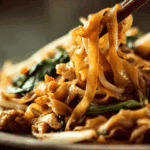
Thai Stir Fried Noodles
- Prep Time: 15 minutes
- Cook Time: 15 minutes
- Total Time: 30 minutes
- Yield: 2 servings 1x
- Category: Main Course
- Method: Stir Fry
- Cuisine: Thai
- Diet: Gluten Free
Description
Authentic Thai stir fry made with wide rice noodles, chicken, egg, and Chinese broccoli in a savory soy and oyster sauce glaze.
Ingredients
- 200g / 7 oz dried wide rice stick noodles, or 15 oz / 450g fresh wide flat rice noodles (Sen Yai)
- 2 tsp dark soy sauce
- 1 1/2 tbsp oyster sauce
- 1 tbsp light soy sauce (or all purpose)
- 2 tsp white vinegar
- 2 tsp sugar (any type)
- 3 tbsp peanut or vegetable oil, separated
- 2 garlic cloves, very finely chopped
- 1 cup / 150g / 5 oz chicken thighs (boneless, skinless), sliced
- 1 large egg
- 4 stems Chinese broccoli
Instructions
- Trim Chinese broccoli ends, cut into 3-inch pieces. Separate stems from leaves. Cut thick stems lengthwise so they are no wider than 0.3 inches.
- Prepare noodles according to packet directions and drain. Cook just before stir frying to avoid breakage.
- Mix all sauce ingredients in a bowl until sugar dissolves.
- Heat 1 tbsp oil in a large wok or skillet over high heat.
- Add garlic, stir fry 15 seconds until fragrant. Add chicken and cook until it turns white but is not fully done.
- Add Chinese broccoli stems, cook until chicken is almost cooked through. Add leaves, stir until wilted.
- Push ingredients to one side, crack egg into empty space, scramble, then mix with chicken and greens.
- Remove chicken and vegetables from wok, scrape clean.
- Heat remaining 2 tbsp oil in wok until smoking. Add noodles and sauce. Toss gently to coat, allowing noodles to caramelize for 1 to 1.5 minutes.
- Return chicken and vegetables to wok, toss everything together quickly, and serve immediately.
Notes
- Use fresh wide flat noodles (Sen Yai) if available for the most authentic texture.
- Do not overcook noodles in boiling water, as they will soften further during stir frying.
- Chinese broccoli is traditional, but you can substitute broccolini or regular broccoli.
- Dark soy provides color and depth, while light soy balances saltiness.
- Cooking oil should have a high smoke point, such as peanut or vegetable oil.
Nutrition
- Serving Size: 1 plate
- Calories: 550
- Sugar: 6g
- Sodium: 890mg
- Fat: 20g
- Saturated Fat: 3.5g
- Unsaturated Fat: 15g
- Trans Fat: 0g
- Carbohydrates: 75g
- Fiber: 3g
- Protein: 25g
- Cholesterol: 95mg
Keywords: Thai Stir Fried Noodles, Pad See Ew, Thai stir fry noodles, rice noodle stir fry, chicken noodle stir fry

